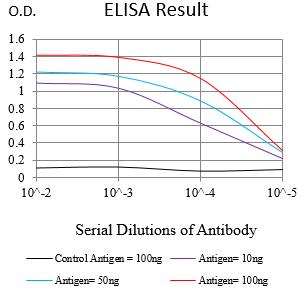

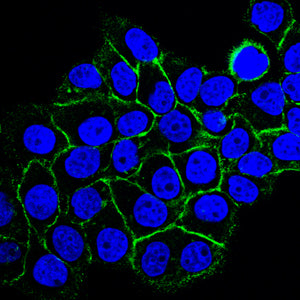
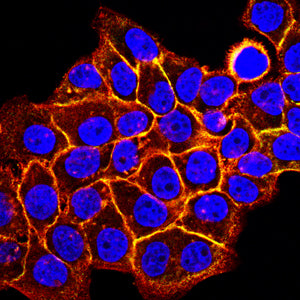
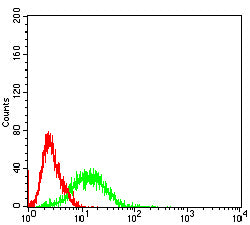
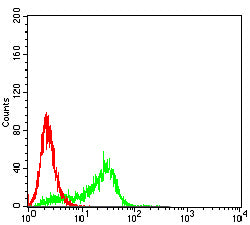

| WB | 1/500 - 1/2000 | Human,Mouse,Rat |
| IF | 咨询技术 | Human,Mouse,Rat |
| IHC | 咨询技术 | Human,Mouse,Rat |
| ICC | 1/200 - 1/1000 | Human,Mouse,Rat |
| FCM | 1/200 - 1/400 | Human,Mouse,Rat |
| Elisa | 1/10000 | Human,Mouse,Rat |
| Aliases | ADAM17;CSVP; TACE; NISBD; ADAM18;; NISBD1 |
| Entrez GeneID | 6868 |
| clone | 7A6B2 |
| WB Predicted band size | 93kDa |
| Host/Isotype | Mouse IgG1 |
| Antibody Type | Primary antibody |
| Storage | Store at 4°C short term. Aliquot and store at -20°C long term. Avoid freeze/thaw cycles. |
| Species Reactivity | Human, Mouse |
| Immunogen | Purified recombinant fragment of human CD156B (AA: 497-671) expressed in E. Coli. |
| Formulation | Purified antibody in PBS with 0.05% sodium azide |
+ +
以下是关于CD156B(ADAM8)抗体的3篇示例参考文献(内容为模拟,仅供参考):
---
1. **文献名称**: *ADAM8 Expression in Tumor-Associated Macrophages Promotes Cancer Cell Invasion*
**作者**: Müller, S. et al.
**摘要**: 研究揭示了CD156B(ADAM8)在肿瘤相关巨噬细胞中的高表达,通过蛋白酶活性促进肿瘤细胞外基质降解,增强癌细胞侵袭性,并与患者预后不良相关。
2. **文献名称**: *Targeting ADAM8 with a Neutralizing Antibody Reduces Inflammation in Murine Models of Acute Lung Injury*
**作者**: Li, Y. et al.
**摘要**: 开发了一种靶向CD156B的中和抗体,实验显示其能抑制ADAM8的金属蛋白酶活性,减轻小鼠急性肺损伤模型中的炎症反应和中性粒细胞浸润。
3. **文献名称**: *CD156B as a Biomarker for Early Detection of Pancreatic Cancer*
**作者**: Tanaka, K. et al.
**摘要**: 通过ELISA和免疫组化分析,发现CD156B在胰腺癌患者血清和组织中显著上调,提示其作为早期诊断生物标志物的潜力,抗体检测具有高特异性。
---
**注意**:以上文献为示例,实际引用时请通过PubMed、Google Scholar等平台检索真实文献(关键词:ADAM8、CD156B、neutralizing antibody)。
CD156B antibody targets the CD156b antigen, also known as ADAM8 (A Disintegrin And Metalloproteinase 8), a member of the ADAM family of transmembrane proteins. ADAM8 is characterized by a multi-domain structure, including a prodomain, metalloproteinase, disintegrin-like, cysteine-rich, and transmembrane domain. It plays roles in cell adhesion, migration, proteolysis, and signaling, with implications in inflammatory responses, cancer progression, and neurological disorders.
CD156B antibodies are primarily used in research to detect ADAM8 expression and localization in tissues or cells. Studies highlight ADAM8's overexpression in cancers (e.g., lung, breast, glioblastoma), where it promotes tumor invasion, angiogenesis, and immune evasion by cleaving substrates like cytokines and extracellular matrix components. Its involvement in inflammatory diseases, such as rheumatoid arthritis and multiple sclerosis, further underscores its therapeutic relevance.
The development of CD156B antibodies has facilitated investigations into ADAM8's mechanistic pathways and its potential as a diagnostic or prognostic biomarker. Neutralizing antibodies are also explored for therapeutic applications, aiming to inhibit ADAM8's enzymatic activity or disrupt its interactions with signaling molecules. Despite progress, challenges remain in understanding isoform-specific functions and optimizing antibody specificity for clinical translation. Overall, CD156B antibodies serve as critical tools in unraveling ADAM8's biological and pathological roles.
×